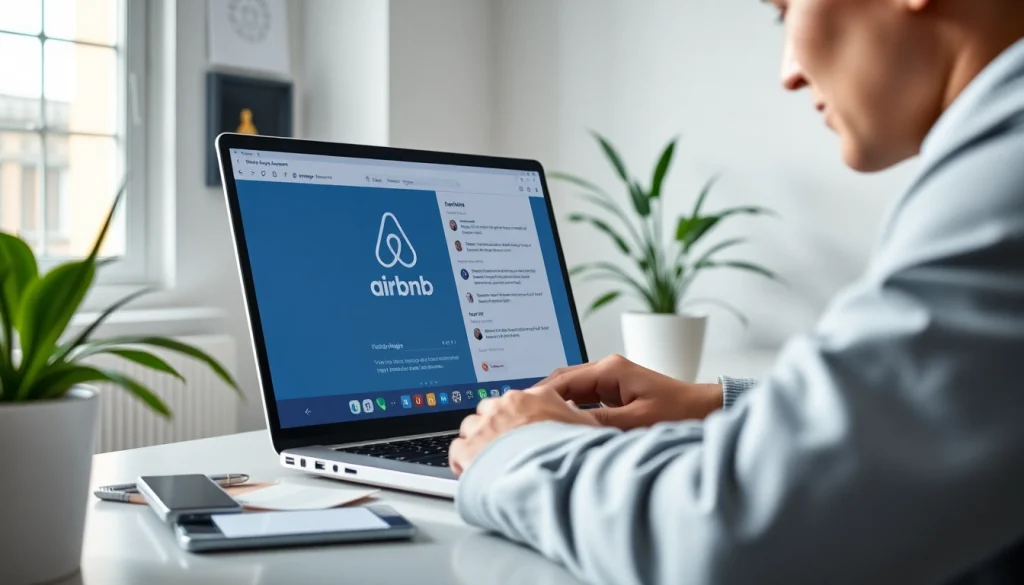Understanding the Need to Automate Airbnb Messages
In the competitive world of Airbnb hosting, effective communication is critical to success. As a host, you frequently find yourself juggling various tasks, from managing bookings to addressing guest inquiries. In this fast-paced environment, the ability to automate Airbnb messages can be a game-changer. By streamlining communication processes, you can enhance guest satisfaction, improve operational efficiency, and ultimately boost your bottom line. This article explores why automating your messaging is not only beneficial but necessary in today’s rental market.
Benefits of Automating Communication
Automating your communication strategy offers a host of benefits:
1. Time-saving efficiency: One of the most significant advantages of automation is the time saved. Pre-written messages for common inquiries (like check-in instructions or FAQs) enable you to handle guest communications swiftly without compromising quality.
2. Consistent messaging: Automation ensures that every guest receives consistent and accurate information. This helps establish a professional image and minimizes misunderstandings.
3. 24/7 availability: Guests may reach out at any time. Automated messages allow you to provide instant responses, even when you are unavailable, enhancing guest experience and satisfaction.
4. Scalability: If you manage multiple properties, automating messages can help you maintain a high standard of communication without becoming overwhelmed. This scalability is essential for hosts looking to expand their business.
5. Reduced Stress: Managing interactions with guests can be stressful, especially during peak seasons. Automation alleviates some of this pressure, allowing you to focus on other critical aspects of your hosting business.
Common Challenges Faced by Hosts
While the benefits of automation are clear, many hosts encounter challenges when implementing automated messaging. Some of these include:
– Crafting the right messages: Deciding what information to include in automated responses can be daunting. You want to ensure that your messages are informative yet concise.
– Maintaining personalization: Automated messages can sometimes feel impersonal. Striking the right balance between automation and individualized communication is essential for a successful guest experience.
– Technical hurdles: For some hosts, the learning curve associated with new technology can deter them from embracing automation. Understanding how to use various tools effectively is critical.
– Adaptability: Guests have diverse needs and preferences. An automation strategy must be flexible enough to accommodate these variations.
When to Consider Automation
Now that we understand the benefits and challenges, when should you consider implementing an automated messaging system? Several scenarios indicate that it’s time to automate:
– High volume of inquiries: If you notice a significant influx of questions from potential or current guests, automation can help manage these demands efficiently.
– Frequent similar interactions: If you find yourself answering the same questions repeatedly, creating an automated response can save you valuable time.
– Expansion of property listings: If you plan to grow your rental portfolio, automation offers an effective way to scale operations without losing touch with your guests.
– Time constraints: If you struggle to keep up with guest communications due to personal or professional commitments, automating messages can help you maintain a high level of engagement.
Choosing the Right Tools for Automation
Selecting an appropriate automation tool is pivotal to effectively implement automated messaging. The right tool should meet your specific needs and integrate seamlessly with your existing operations.
Overview of Popular Automation Tools
Several automation tools cater to Airbnb hosts, each with its unique features. When exploring automation solutions, consider the following:
– Chatbots: These artificial intelligence-driven tools can handle routine guest inquiries in real-time, providing instant answers and freeing up your time.
– Messaging platforms: Many hosts utilize specific platforms designed for Airbnb messaging that allow for template creation, scheduling, and integrations with other tools.
– Property management systems: Comprehensive management systems often include messaging capabilities, allowing you to streamline all aspects of property management in one place.
– Custom automation solutions: For tech-savvy hosts, there are options for building custom solutions that uniquely fit your needs, though these can be more complicated to implement.
Evaluating Features and Ease of Use
When selecting an automation tool, several features should be considered:
– User-friendly interface: Look for tools that are intuitive and easy to navigate. A complicated interface can defeat the purpose of automation by consuming more of your time.
– Customizable templates: The ability to create and customize message templates is vital, allowing you to maintain responsiveness while adapting your voice and branding.
– Integrations: Consider tools that integrate well with your current property management system, booking platforms, or other technologies you use.
– Analytics and reporting: Tools that offer insights into message effectiveness can help you refine your automation strategy for better results.
Cost Considerations and Budgeting
Budgeting for an automation tool also requires careful consideration. Here are some factors to keep in mind:
– Upfront costs vs. long-term benefits: While some tools may have a high initial investment, weigh these costs against the potential savings in time and improved guest satisfaction.
– Subscription models: Many tools operate on a subscription basis, providing flexibility but requiring ongoing investment.
– Trial options: Look for tools that offer free trials or demo versions, allowing you to evaluate effectiveness before making a financial commitment.
– ROI calculations: Consider how automation could impact your revenue and guest retention. A well-chosen tool can lead to substantial financial gains.
Setting Up Your Automated Messaging System
Once you’ve chosen the right tool, it’s time to set up your automated messaging system effectively. A strategic approach can lead to a seamless implementation.
Creating Template Messages for Guests
Creating compelling template messages is essential for effective automation. Here are steps to guide you:
1. Identify common inquiries: Analyze past communication to identify frequently asked questions and requests.
2. Draft clear and concise messages: Ensure your templates provide all necessary information in a friendly and approachable tone.
3. Include personalization prompts: Use placeholders to insert guest names or other specific information to make the messages feel personalized.
4. Review and refine: Seek feedback from trusted friends or colleagues to ensure clarity and effectiveness.
5. Categorize templates: Organize your messages into specific categories such as pre-booking inquiries, check-in instructions, and post-stay follow-ups for easy navigation.
Scheduling Automatic Responses
The timing of your automated messages can significantly influence their effectiveness. Here’s how to handle scheduling:
1. Identify key moments for communication: Determine the optimal timing for sending messages, whether pre-check-in, during the stay, or post-check-out.
2. Use scheduling features: Most automation tools allow you to schedule messages for specific times or trigger them based on events (e.g., booking confirmations).
3. Consider time zones: If you host international guests, consider their time zones when scheduling messages to ensure timely communication.
4. Test timing effectiveness: Monitor response rates and adjust your scheduling if certain messages lead to higher engagement at specific times.
Testing and Adjusting Your Automation Strategy
Once your automated system is in place, regular testing and adjustments are crucial:
1. Analyze performance metrics: Look at analytics provided by your automation tool to measure the success of your messaging strategy.
2. Solicit guest feedback: After their stay, request feedback specifically on the communication they received to identify areas for improvement.
3. A/B testing: Experiment with different messages, timings, and templates to find the most effective combinations.
4. Stay adaptable: Update your messages regularly based on trends or changes in guest preferences and ensure that automation evolves with your business.
Best Practices for Managing Automated Messages
To get the most out of your automated messaging system, follow these best practices:
Personalizing Automated Replies for Better Engagement
Though automation can streamline your communication, it’s essential to maintain a personal touch:
– Use guest names: Personalizing messages with the guest’s name establishes a connection and enhances engagement.
– Tailor messages based on reservation details: Reference the specifics of their booking, such as dates or the number of guests, to create a sense of attention and care.
– Respond to previous conversations: If a guest asks a specific question, refrain from sending generic responses. Tailor your automation to address individual inquiries directly.
Monitoring and Analyzing Response Rates
Monitoring how guests interact with your automated messages provides critical insights:
– Use analytics tools: Employ analytics capabilities within your automation tool to evaluate open and response rates.
– Identify trends: Note which messages garner more engagement and which fall flat, allowing you to refine your strategy continually.
– Stay updated on guest preferences: Trends in guest communication preferences can change; regular monitoring keeps your strategies relevant and effective.
Adapting to Guest Feedback
Feedback from guests offers invaluable insights for improving your automated messaging:
– Create a feedback loop: Incorporate simple post-stay surveys asking guests how they found the automated communication.
– Make adjustments based on responses: Analyze feedback quantitatively and qualitatively, making necessary changes to your messaging strategy.
– Engage directly: If a guest expresses dissatisfaction with automated messaging, consider personal communication to rebuild rapport and take their suggestions seriously.
Case Studies: Successful Automation of Airbnb Messages
Real-world examples can illustrate the value and effectiveness of automating Airbnb messages.
Examples of Hosts Who Thrived
Numerous Airbnb hosts who have implemented automation tools have reported transformative experiences. For instance, one host managing multiple properties in a busy tourist destination reduced time spent on guest communication by over 60% after implementing an automated system.
Another host shared how automated messages improved their booking conversion rates by providing instant responses to inquiries. This timely communication built trust among potential guests, leading to increased bookings.
Lessons Learned from Real-World Experiences
From these examples, several key lessons emerge:
– Test before full implementation: Successful hosts often start small, testing automated messages before launching a full-scale strategy to ensure messages resonate.
– Evolve with guest needs: Continuous adaptation of the messaging strategy to the changing landscape of guest expectations is crucial for sustained success.
– Balance automation with personal interactions: While automation enhances efficiency, combining automation with strategic personal communication can yield optimal guest satisfaction.
Future Trends in Airbnb Message Automation
As technology evolves, so too will the landscape of Airbnb message automation. Some trends to watch include:
– Advanced AI and machine learning: As AI technology improves, hosts can expect smarter automation tools that offer enhanced capabilities, like context-aware messaging.
– Integration with smart home technology: Future iterations of messaging systems may include integrations with smart home devices, further personalizing the guest experience.
– Increased emphasis on data-driven strategies: More focus will be placed on leveraging data analytics to refine automation strategies for maximum guest engagement.
By staying informed about these trends, hosts can continuously improve their messaging strategies, ensuring they remain competitive in a dynamic market.


